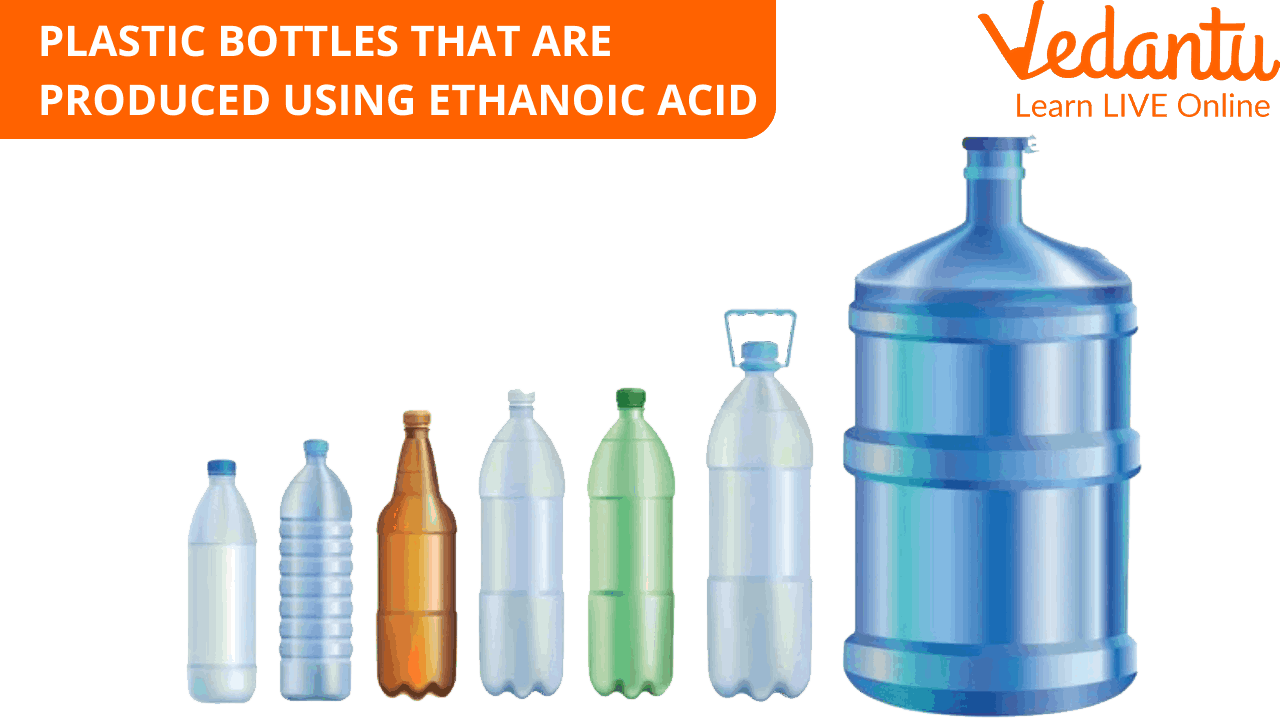




Ethanoic Acid
Ethanoic is also referred to as ethanoic acid. It is a two-carbon acid and, thus, the carboxylic acid family's second member after methanoic acid (which is a one-carbon carboxylic acid). Although ethanoic acid is the correct and scientifically justified IUPAC name for this acid, its common name, acetic acid, is also mentioned as the IUPAC name in many places. Vinegar, a common household substance used in kitchens, is a solution of 5-8% Ethanoic Acid in water.
What is Ethanoic Acid?
Acetic acid, also known as ethanoic acid, is a mild carboxylic acid. C2H4O2 is the primary acetic acid formula. Acetic acid has two carbons, four hydrogens, and two oxygens in its formula. The acetic acid formula is sometimes written as CH3COOH.
Ethanoic Acid Examples
Vinegar acid
Ethylic acid
Methanecarboxylic acid
Glacial acetic acid
Glacial ethanoic acid
Characteristics of Ethanoic Acid
Acetic acid has a flammable temperature of 39°C.
It has a boiling point of 118° Celsius.
Acetic acid has been classified as a flammable organic chemical.
Acetic acid is a hygroscopic substance because it absorbs moisture.
It reacts strongly with both acid and base.
High concentrations of acetic acid can corrode metal and deteriorate plastics and rubber.
Ethanoic Acid Applications
Acetic acid has several applications in a variety of fields. Ethanoic or acetic acid has several industrial applications. The following are some of them:
Acetic acid or ethanoic acid is utilised to produce esters, vinegar, and a variety of polymeric compounds.
It is often used as a catalyst in labs but may also be used on a more significant industrial basis. Acetic acid is utilised in the production of various compounds in chemical plants.
Before examining white blood cells, this chemical is used to separate them from red blood cells.
Acetic acid is utilised in the production of plastics and other synthetic materials.
Ethanoic acid is used to manufacture dyes, pigments, paint and coating agents.
Acetic acid is a chemical extensively used in photographing products such as film and chemical reagents.
Ethanoic acid is also used in the petroleum sector to coat and treat surfaces, such as those on automobiles.
Acetic acid is used in pest management products such as herbicides and insecticides, as well as antifreeze and de-icing agents.
It is also present in several ear drops because acetic acid has antifungal and antibacterial properties.
Acetic acid is a food ingredient, flavouring, and preservative in lower amounts. It also controls the acidity of the food.
Vinegar preserves fruits and vegetables in pickling because acetic acid stops the growth of microorganisms.

Plastic Bottles That are Produced Using Ethanoic Acid
Summary
Ethanoic acid is an organic compound that can be used as a chemical intermediate, as a reagent in organic synthesis, and to produce other chemicals. In modern life, ethanoic acid is an essential chemical compound used to manufacture products such as plastic, detergents, pesticides, and pharmaceuticals. Acetic acid is used commercially to create metal acetates, textiles, photographic films, some printing processes, volatile organic esters, and as a lubricant for resins and paints. Acetic acid is a crucial biological catalyst that naturally occurs in plant juices and bodily fluids.
FAQs on Uses of Ethanoic Acid
1. How is ethanoic acid helpful in the food industry?
Acetic acid used in food is a sour ingredient that may be used in sauce, vinegar, pickled vegetables, and as a raw material for spices.
2. Why is ethanoic acid called Glacial acetic acid?
Due to its low melting point of 16°C, which causes it to freeze fast in frigid temperatures, ethanol is often referred to as glacial acetic acid.
3. How is acetic acid beneficial for farmers?
Farmers use acetic acid to prevent fungal and bacterial growth on stored fodder for livestock.
4. What is an ester?
Ester is the product of the reaction of a carboxylic acid with an alcohol. They have a sweet fruity aroma. They are primarily used in the production of perfumes and synthetic flavouring agents.









